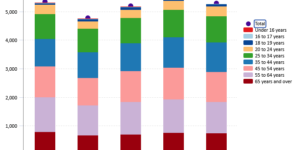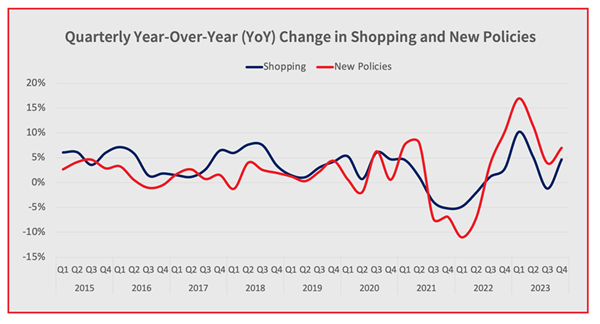The auto insurance market is seeing higher claims frequency, in part, due to increasingly risky driving behavior and greater EV adoption which comes with expensive advanced technology, according to the latest 2024 U.S Auto Insurance Trends Report, a new report released by LexisNexis Risk Solutions.
Risky driving behavior rose among younger demographics as distracted driving violations by Gen Z increased 24 percent from 2022 and a staggering 66 percent in comparison to 2019.
High claim severities persist due to parts and labor shortages along with rising attorney involvement, with 93 percent of claimants who sought legal counsel likely to retain services in the future.
Claim severity has steadily trended upward since the pandemic, the report stated. Compared to 2020, bodily injury has risen by 20 percent, along with severity as material damage has increased by 47 percent.
In 2023, over a quarter (27 percent) of collision claims were deemed total losses, requiring payouts and consumers to replace a vehicle or find alternate transportation.
Attorney involvement has helped contribute to the rise in claims costs.
Over half (51 percent) of claimants who hired an attorney received a higher settlement amount.
This activity is most prevalent following an auto accident, as 85 percent of claimants were approached by one attorney and 60 percent by more than one.
Consumer dissatisfaction around total loss remains high, the report noted, with roughly half (46 percent) of auto insurance customers frustrated with lengthy claims process times.
The time required to settle a claim is the highest determinant of customer satisfaction, followed by the number of people and touches needed to resolve the claim.
Auto insurers have been aggressive in their pricing, with an unprecedented 14 percent year-over-year rate increase in 2023, improving the combined loss ratio to 105 percent, a 7-point improvement over 112 percent in 2022.
The record-setting rate increases (9 percent increase in 2022 and 14 percent in 2023) have led to increased policy shopping and switching levels among auto insurance consumers, with new policies increasing by 6.2 percent in 2023.
Among consumers who had auto insurance at the end of 2023, 41 percent shopped at least once for a new policy.
Overall, shopping increased 4.7 percent in 2023.
Consumer retention rates dropped from 83 to 80 percent, indicating there may be a need for insurers to focus on their existing portfolios and take steps to update their underwriting practices over the course of 2024, the report suggested.
In 2023, EV sales grew 54 percent compared to Light Duty Vehicles (LDVs) sales growth of 13 percent.
The total number of EVs insured grew by 40 percent to 3.9 million in 2023, while the number of private passenger vehicles (PPAs) insured grew by only 1.2 percent in the same period, to a total of 265 million.
Consumer EV shopping behavior showed that 24 percent of new EV buyers shopped around for lower rates on their auto insurance policies in 2023, significantly higher than the 19 percent of new PPA buyers that shopped for coverage last year.
Differing driving experiences in electric vehicles (EVs) have contributed to higher and more severe claims than internal combustion engine (ICE) vehicles.
In 2023, LexisNexis noted that claim frequency and severity for EVs were 17 percent and 34 percent higher, respectively, than traditional segments.
“Auto insurers are navigating a dynamic and challenging market environment in 2024. For their part, consumers are displaying more unpredictable driving and policy shopping behavior, and increasingly switching carriers to find better rates,” said Adam Pichon, senior vice president of global analytics, insurance, LexisNexis Risk Solutions. “It is crucial for insurers to balance market acquisition and retention with rate adequacy and utilize data-driven insights to help manage risk and maintain profitability to be set up for continued success as the market begins to soften.”
Major speeding violations (up 10 percent from 2022-2023, up 36 percent since 2019) and minor speeding violations (up 16 percent from 2022-2023, up 15 percent since 2019) continue to increase.
Younger drivers exhibit distracted driving more frequently, especially Gen Z. From 2022-2023, violations for the age group increased by 24 percent and, compared to 2019 figures, have risen 66 percent.
More disturbing, distracted driving across all age demographics rose 10 percent from 2022-2023.
Despite overall combined ratio improvements in 2023, insurers are still working towards profitability in many states with additional rate increases being enacted across the country, LexisNexis said.
An interesting trend seen during 2022 and 2023 is that the number of drivers within a policy increased by 5 percent, pointing to changing risk profiles that may be overlooked during renewal periods and potentially indicating consolidation in households, LexisNexis added.





















 Most Distracting Holiday Songs for Drivers Ranked
Most Distracting Holiday Songs for Drivers Ranked  Dear Elon and Vivek: Insurance Commissioners Urge DOGE to Ditch FIO
Dear Elon and Vivek: Insurance Commissioners Urge DOGE to Ditch FIO  Surviving the ‘Silver Tsunami’: Closing the Talent, Skills Gap in Underwriting
Surviving the ‘Silver Tsunami’: Closing the Talent, Skills Gap in Underwriting  Reporter’s Notebook: ‘Nobody Else Does Telematics,’ Lemonade Exec Says
Reporter’s Notebook: ‘Nobody Else Does Telematics,’ Lemonade Exec Says 




